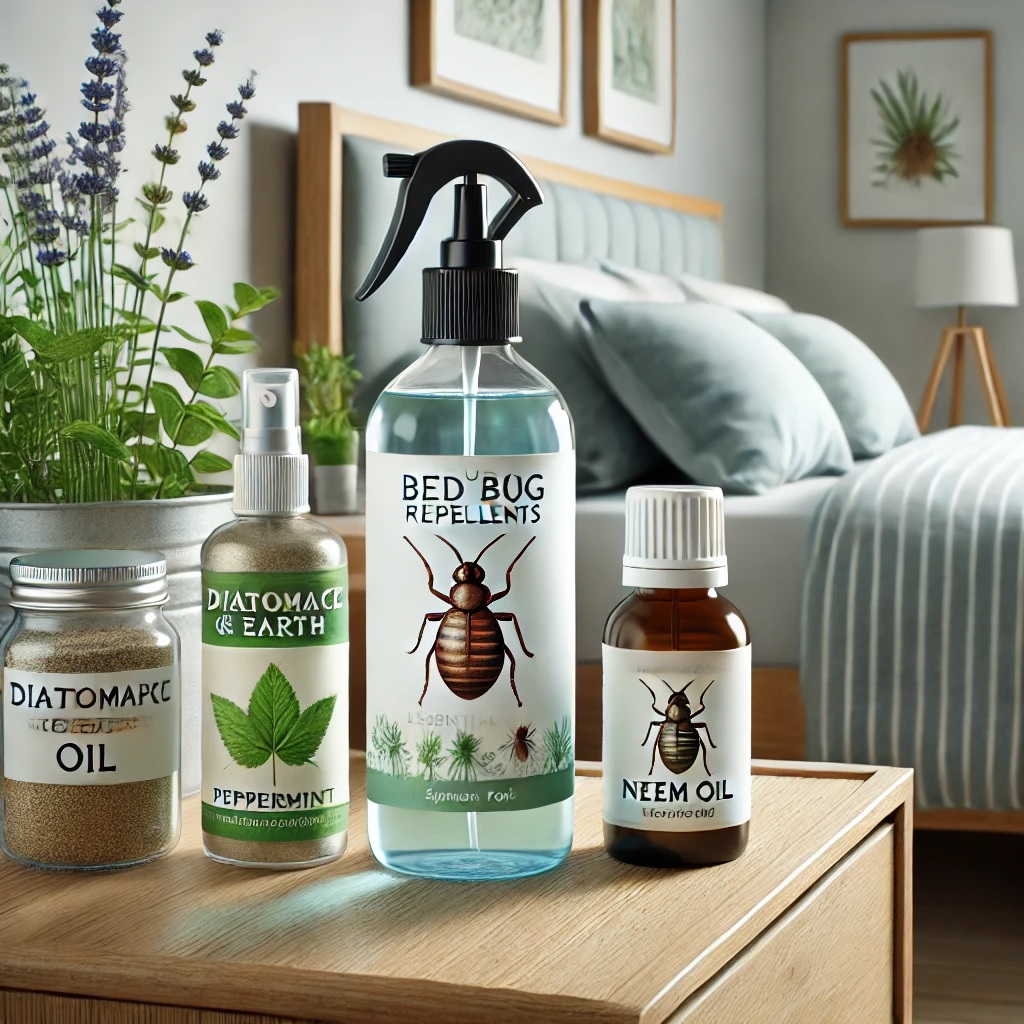Nobody wants bed bugs, but nobody wants harsh chemicals in their home either. At ThermoPest, we’ve heard from plenty of customers who are looking for ways to keep bed bugs away without using strong pesticides, especially when there are kids or pets around. That’s where natural bed bug repellents come in. They’re safe, non-toxic, and, when used properly, can help prevent these unwanted pests from making themselves at home.
So, let’s explore some of the best natural methods to repel bed bugs and how to use them effectively.

What Are Natural Bed Bug Repellents?
Natural bed bug repellents are exactly what they sound like: alternatives to chemical treatments. They use naturally occurring ingredients to either repel or kill bed bugs, and they’re becoming more popular because people want to avoid bringing strong chemicals into their bedrooms.
Whether it’s essential oils, powders like diatomaceous earth, or common household items like vinegar, these natural options can be an effective first line of defence. Let’s break down how they work and why so many people are turning to them.
Why Use Natural Repellents?
Why bother with natural repellents, you ask? It’s pretty simple: they’re safe, especially in homes with children or pets. Harsh chemicals can pose health risks, especially for those with sensitivities, so using non-toxic solutions is a no-brainer for many families. Plus, who wouldn’t want an eco-friendly option that’s both easy on the environment and gentle on your home?
I’ve seen first-hand how using these methods gives peace of mind without compromising on effectiveness. While they might not completely replace professional treatments for serious infestations, they’re brilliant for prevention or managing light problems.
Common and Effective Natural Bed Bug Repellents
Now, onto the good stuff: what actually works? Here’s a rundown of some of the most popular and effective natural bed bug repellents.
1. Essential Oils
Essential oils are a popular choice because they’re easy to find and smell great (to us, not to bed bugs). Oils like lavender, peppermint, tea tree, and eucalyptus work by masking the scent that bed bugs are attracted to, essentially repelling them.
How to use them: Mix a few drops of essential oil with water in a spray bottle and spritz it around your mattress, bed frame, and other places bed bugs might hide. I’ve had customers tell me they love using this method not only because it works, but because it leaves their room smelling lovely and fresh.
2. Diatomaceous Earth
If you’ve never heard of diatomaceous earth, let me introduce you to a game-changer. This fine powder, made from fossilised aquatic organisms, works by dehydrating bed bugs when they come into contact with it. It’s completely safe for humans and pets, making it one of my favourite recommendations for a natural solution.
How to use it: Lightly sprinkle diatomaceous earth around your bed, baseboards, and in any cracks where bed bugs might hide. Just make sure to vacuum it up after a few days and reapply if needed. A mask might be useful while applying, as it can be a bit dusty.
3. Neem Oil
Neem oil is a natural insecticide that not only repels bed bugs but also disrupts their ability to grow and reproduce. It’s widely used in organic pest control for all kinds of insects, including bed bugs.
How to use it: Apply a small amount of diluted neem oil around your bed and furniture. Bed bugs can’t stand the smell, and it stops them from laying eggs or maturing into adults, which helps to control any growing infestations.
4. Vinegar
Vinegar is one of those multi-purpose household items that can even help with bed bugs. While it won’t kill them long-term, vinegar can act as a contact repellent by breaking down their exoskeleton on contact.
How to use it: Fill a spray bottle with white vinegar and spray directly on bed bugs if you spot any. It’s not a complete fix, but it can slow them down while you explore other treatment options.
5. Baking Soda
Some people swear by baking soda for bed bug control. It’s believed to absorb moisture from bed bugs and dehydrate them, though there’s not much scientific proof backing this up.
How to use it: If you want to try it, sprinkle baking soda around the areas where you think bed bugs are hiding, then vacuum it up after a few days and reapply if needed.
How to Use Natural Bed Bug Repellents
Knowing which products to use is only half the battle. The real trick lies in knowing how and where to apply them for the best results.
Best Places to Apply Repellents
Bed bugs like to hide in cracks, seams, and crevices. The key areas to target with your natural repellents include:
- Mattress seams and bed frames: These are prime spots for bed bugs to hide.
- Cracks and skirting boards: Don’t forget to treat around the edges of the room, where bed bugs often travel.
- Furniture crevices: If you have upholstered furniture in the bedroom, treat these areas as well.
Creating Homemade Repellent Sprays
One of the easiest ways to use natural repellents is by making your own DIY sprays. Combine a few drops of essential oils like lavender or peppermint with water in a spray bottle. This is great for daily spritzing around the bed to keep those bugs at bay.
Reapplication and Maintenance
Natural bed bug repellents work best when applied consistently. Unlike chemical treatments, which can last longer, natural solutions need to be reapplied more frequently – usually every few days or after cleaning. The key is to stay on top of it.
Advantages and Disadvantages of Natural Bed Bug Repellents
Like any treatment, there are pros and cons to going natural.
Advantages:
- Safe for homes with children and pets: No need to worry about harmful chemicals around your family.
- Eco-friendly and affordable: Natural products are often less expensive than commercial pesticides and don’t harm the environment.
- Great for light infestations or prevention: These repellents can keep bed bugs at bay before they become a major problem.
Disadvantages:
- Shorter-lasting effects: You’ll need to reapply natural repellents frequently.
- May not be strong enough for severe infestations: If you’ve got a major bed bug issue, natural remedies might not be enough on their own.
Combining Natural Repellents with Other Preventive Measures
To get the best results, it’s smart to combine natural repellents with other methods to make sure bed bugs don’t stand a chance.
Using Mattress Encasements and Interceptors
Bed bug-proof mattress encasements and interceptor traps work wonders when used alongside natural repellents. Encasements stop bed bugs from getting into your mattress, and interceptors trap them before they can climb into bed.
Cleaning and Decluttering
Routine home maintenance is just as important. Regular vacuuming, washing bedding on high heat, and decluttering your space can make it much harder for bed bugs to settle in.
Natural Bed Bug Prevention When Travelling
If you’re someone who travels often, it’s worth taking natural repellents with you. Spraying your luggage and hotel bedding with an essential oil spray can help stop bed bugs from hitching a ride home with you.
When to Seek Professional Help
While natural bed bug repellents can be effective, they do have their limits.
Recognising When Natural Repellents Aren’t Enough
If you’re still seeing bed bugs despite using natural repellents, or if you’re waking up with bites every morning, it’s time to consider professional help. Bed bugs can reproduce quickly, and if they’ve settled into your home, it’s going to take more than essential oils to get rid of them.
How Natural Repellents Can Complement Professional Treatments
Even if you do need professional treatment, you can still use natural repellents alongside it to keep bed bugs away in the long term. At ThermoPest, we often recommend combining natural methods with professional treatments for a complete approach to bed bug control.

Time to Repel Bed Bugs Naturally
Natural bed bug repellents are a great option if you’re looking for a safe, eco-friendly way to keep bed bugs at bay. Whether you’re using essential oils, diatomaceous earth, or neem oil, these methods can provide peace of mind and help prevent bed bug infestations. Just remember, staying consistent with application and using them alongside other preventive measures will give you the best results.
If you’re struggling with a more serious bed bug problem, or just want some expert advice, ThermoPest is here to help. We offer professional bed bug treatments that can work alongside natural methods to keep your home pest-free. Give us a call today, and let’s get those bed bugs sorted!
